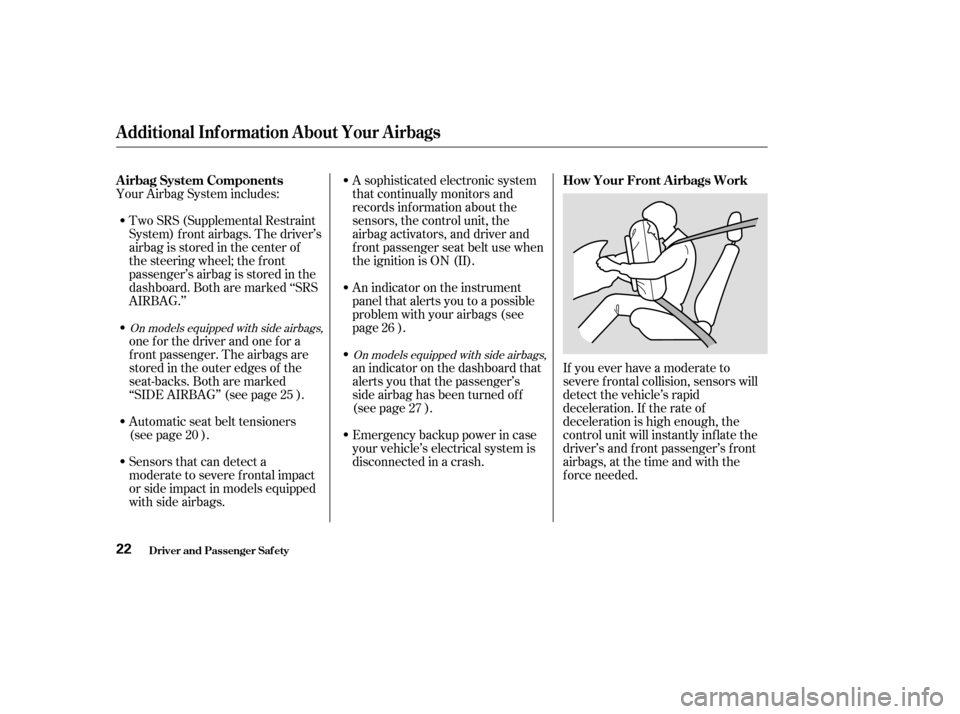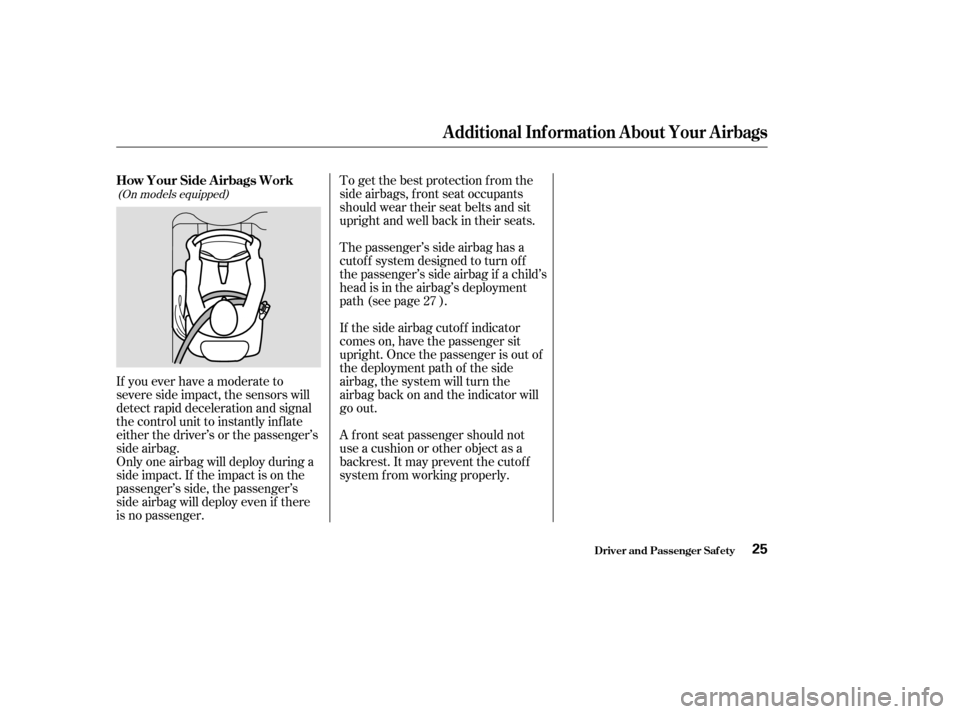Page 21 of 221

Your Airbag System includes:Two SRS (Supplemental Restraint
System) f ront airbags. The driver’s
airbag is stored in the center of
the steering wheel; the f ront
passenger’sairbagisstoredinthe
dashboard. Both are marked ‘‘SRS
AIRBAG.’’ A sophisticated electronic system
that continually monitors and
records inf ormation about the
sensors, the control unit, the
airbag activators, and driver and
frontpassengerseatbeltusewhen
the ignition is ON (II).
Emergency backup power in case
your vehicle’s electrical system is
disconnected in a crash.
If you ever have a moderate to
severe f rontal collision, sensors will
detect the vehicle’s rapid
deceleration. If the rate of
deceleration is high enough, the
control unit will instantly inf late the
driver’s and f ront passenger’s f ront
airbags, at the time and with the
f orce needed.
Sensors that can detect a
moderate to severe frontal impact
or side impact in models equipped
with side airbags.
Automatic seat belt tensioners
(see page ).
one f or the driver and one f or a
f ront passenger. The airbags are
stored in the outer edges of the
seat-backs. Both are marked
‘‘SIDE AIRBAG’’ (see page ). An indicator on the instrument
panel that alerts you to a possible
problem with your airbags (see
page ).
an indicator on the dashboard that
alerts you that the passenger’s
side airbag has been turned of f
(see page ).
20 25 26
27
On models equipped with side airbags, On models equipped with side airbags,
Additional Inf ormation About Your Airbags
Driver and Passenger Saf ety
Airbag System Components How Your Front Airbags Work
22
�����—�����—�����y�
����
����
���y���
�(�����������y���������y
Page 24 of 221

(On models equipped)
If you ever have a moderate to
severe side impact, the sensors will
detect rapid deceleration and signal
the control unit to instantly inf late
either the driver’s or the passenger’s
side airbag.
Only one airbag will deploy during a
side impact. If the impact is on the
passenger’s side, the passenger’s
side airbag will deploy even if there
is no passenger.To get the best protection f rom the
side airbags, front seat occupants
should wear their seat belts and sit
upright and well back in their seats.
The passenger’s side airbag has a
cutof f system designed to turn of f
the passenger’s side airbag if a child’s
head is in the airbag’s deployment
path (see page ).
If the side airbag cutof f indicator
comes on, have the passenger sit
upright. Once the passenger is out of
the deployment path of the side
airbag, the system will turn the
airbag back on and the indicator will
go out.
A f ront seat passenger should not
use a cushion or other object as a
backrest. It may prevent the cutof f
system f rom working properly.
27
Additional Inf ormation About Your Airbags
Driver and Passenger Saf ety
How Your Side A irbags Work
25
�����—�����—�����y�
����
��������y���
�(�����������y���������y
Page 200 of 221
If you are planning to take your
Honda outside the U.S. or Canada,
contact the tourist bureaus in the
areas you will be traveling in to f ind
out about the availability of unleaded
gasoline with the proper octane
rating.
If unleaded gasoline is not available,
be aware that using leaded gasoline
in your Honda will af f ect perf or-
mance and fuel mileage, and damage
its emissions controls. It will no
longer comply with U.S. and
Canadian emissions regulations, and
will be illegal to operate in North
America. To bring your vehicle back
into compliance will require the re-
placement of several components,
such as the oxygen sensors and the
three way catalytic converter. These
replacements are not covered under
warranty.
Driving in Foreign Countries
T echnical Inf ormation201
�����—�����—�����y�
�������������y���
�(�����������y���������y
Page 202 of 221

The exhaust emissions controls
include three or f our systems: PGM-
FI, Ignition Timing Control, Exhaust
Gas Recirculation (SOHC VTEC
engine only), and Three Way
Catalytic Converter. These three or
f our systems work together to
control the engine’s combustion and
minimize the amount of HC, CO, and
NOx that comes out the tailpipe. The
exhaust emissions control systems
are separate from the crankcase and
evaporative emissions control
systems.
The PGM-FI System uses sequential
multiport f uel injection.
It has three subsystems: Air Intake,
Engine Control, and Fuel Control.
The Engine Control Module (ECM)
or the Powertrain Control Module
(PCM) uses various sensors to
determine how much air is going
into the engine. It then controls howmuch f uel to inject under all operat-
ing conditions.
This system constantly adjusts the
ignition timing, reducing the amount
of HC, CO, and NOx produced.
The Exhaust Gas Recirculation
(EGR) system takes some of the
exhaust gas and routes it back into
the intake manif old. Adding exhaust
gas to the air/f uel mixture reduces
the amount of NOx produced when
the f uel is burned.
The three way catalytic converter is
in the exhaust system. Through
chemical reactions, it converts HC,
CO, and NOx in the engine’s exhaust
to carbon dioxide (CO ), nitrogen
(N ), and water vapor.
The emissions control systems are
designed and certif ied to work to-
gether in reducing emissions to
levels that comply with the Clean Air
Act. To make sure the emissions
remain low, you should use only new
genuine Honda replacement parts or
their equivalent f or repairs. Using
lowerqualitypartsmayincreasethe
emissions f rom your vehicle.
The emissions control systems are
covered by warranties separate f rom
the rest of your vehicle. Read your
warranty manual f or more inf orma-
tion.
2
2
Emissions Cont rols
T echnical Inf ormation
Exhaust Emissions Controls Replacement Parts
PGM-FI Syst emIgnit ion T iming Cont rol Syst em
Exhaust Gas Recirculat ion (EGR)Syst em
Three Way Catalytic Converter
203
�����—�����—�����y�
�������������y���
�(�����������y���������y